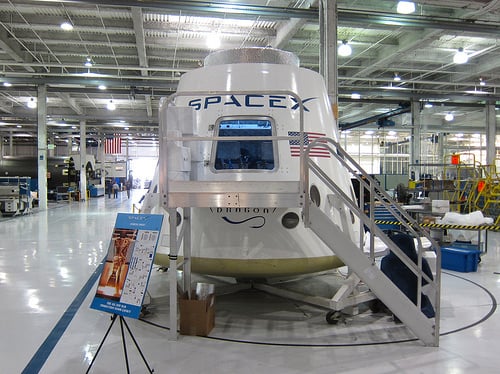Last week, the world got a glimpse of how Space Exploration Technologies (SpaceX) Chief Executive Officer Elon Musk is using cutting-edge technology from Tesla (Nasdaq: TSLA), his electric car company, to create a spacecraft.
At SpaceX's Hawthorne, Calif., headquarters Thursday evening, Musk wowed a crowd of employees, aerospace industry experts, and journalists with the rollout of SpaceX's newest manned space capsule: the Dragon V2.
The 15-foot tall, "fire-breathing" Dragon V2 is capable of ferrying up to seven passengers and four tons of cargo to and from the orbital International Space Station (ISS).

While focus was on the spacecraft's exterior and engines, the Tesla-inspired interior touch screens also garnered a great deal of attention.
The two 17-inch touch screens, which make up the main control space, help the Dragon V2 with precision landing. Musk was quick to boast the screens were taken from the design of the Tesla Model S electric car.
"The touch screens are sort of a ruggedized version of what was used in the Tesla Model S so there's a bit of technology sharing there... and the great thing about a 17-inch touch screen... [is that] you can configure the interface to have a wide range of controls and a wide range of feedback, and you can really have almost an infinite amount of information," Musk said. "In the unlikely event of all the screens being destroyed, the critical functions can all be controlled with manual buttons in terms of manual chute deploy and reserve oxygen going to the backup systems for life support."
Propelling the new capsule are Musk's new SuperDraco engines. The engines are 200 times more powerful than its current space capsule engines. They've passed stringent qualification testing and will be used on the Dragon V2 to run the Launch and Abort System and to facilitate precision landing.
Indeed, no worries of the capsule landing in no-man's land or out in the ocean. According to Musk, the Dragon V2 will "have the landing accuracy of a helicopter."
The Dragon V2, a modern-day, sleek version of the Apollo capsules, has been in development for several years with NASA's assistance. It will be part of a new generation of commercial space vehicles, in demand since the United States closed its shuttle program in 2011.
SpaceX has already demonstrated it can deliver supplies to the Space Station via its unmanned spaceship, under contract with NASA. The next goal is to regularly fly passengers back and forth from the ISS.
SpaceX can travel up to 10 missions before its protective heat shield requires refurbishing. In contrast, the Apollo capsules of the 1960s, which splashed down somewhere in the Earth's oceans, couldn't be reused.
The ability to reuse the spacecraft is key to cost-efficient space travel.
"As long as we continue to throw away rockets and spacecraft, we will never truly have access to space," Musk told reporters. "It'll always be incredibly expensive."
NASA presently pays Russia some $71 million per person to taxi astronauts to and from the ISS on Russia's Soyuz vehicles. Musk says his company foresees transporting astronauts to the ISS for roughly $20 million per round-trip seat. Moreover, as the number of flights to the ISS increases, the cost-per-person could come down significantly to where it could "potentially get into the single-digit-million figure."
SpaceX's mission is to revolutionize space technology and provide a way for humans to live on other planets.
Prospects of regular space taxi services for civilians may seem a bit out there. But the same was said not too long ago of electric cars, now mainstream and, thanks to Tesla, highly desirable.
Manned tests of the Dragon V2 are expected to begin by 2016.
Editor's Note: While you can't invest in SpaceX stock, you can still make money from Elon Musk's innovative moves. He's helped Tesla stock gain a whopping 238% in the past year - and the company is not slowing down.
Now Tesla is engaged in a highly sensitive venture called BlueStar that could disrupt $737 billion of the U.S. economy and impact 98% of the population.
Few details concerning BlueStar have made their way into the press. However, a recent investigation uncovered some shocking revelations... take a look.
Related Articles:


